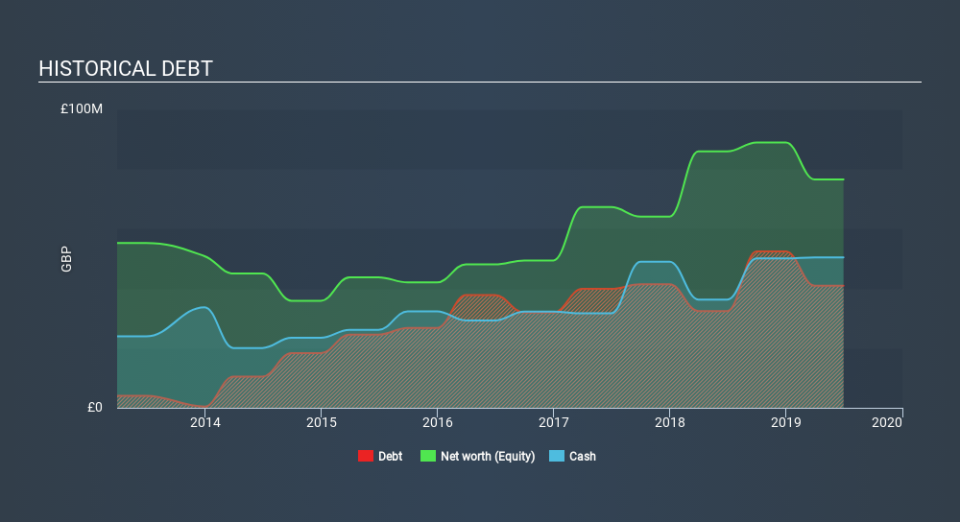M&C Saatchi (LON:SAA) Seems To Use Debt Quite Sensibly

The external fund manager backed by Berkshire Hathaway's Charlie Munger, Li Lu, makes no bones about it when he says 'The biggest investment risk is not the volatility of prices, but whether you will suffer a permanent loss of capital. When we think about how risky a company is, we always like to look at its use of debt, since debt overload can lead to ruin. As with many other companies M&C Saatchi plc (LON:SAA) makes use of debt. But should shareholders be worried about its use of debt?
Why Does Debt Bring Risk?
Debt assists a business until the business has trouble paying it off, either with new capital or with free cash flow. Ultimately, if the company can't fulfill its legal obligations to repay debt, shareholders could walk away with nothing. However, a more usual (but still expensive) situation is where a company must dilute shareholders at a cheap share price simply to get debt under control. Having said that, the most common situation is where a company manages its debt reasonably well - and to its own advantage. The first thing to do when considering how much debt a business uses is to look at its cash and debt together.
See our latest analysis for M&C Saatchi
How Much Debt Does M&C Saatchi Carry?
The image below, which you can click on for greater detail, shows that at June 2019 M&C Saatchi had debt of UK£40.9m, up from UK£32.4m in one year. However, it does have UK£50.4m in cash offsetting this, leading to net cash of UK£9.51m.
How Strong Is M&C Saatchi's Balance Sheet?
We can see from the most recent balance sheet that M&C Saatchi had liabilities of UK£172.6m falling due within a year, and liabilities of UK£61.1m due beyond that. Offsetting these obligations, it had cash of UK£50.4m as well as receivables valued at UK£132.9m due within 12 months. So its liabilities total UK£50.4m more than the combination of its cash and short-term receivables.
This deficit is considerable relative to its market capitalization of UK£81.9m, so it does suggest shareholders should keep an eye on M&C Saatchi's use of debt. This suggests shareholders would heavily diluted if the company needed to shore up its balance sheet in a hurry. While it does have liabilities worth noting, M&C Saatchi also has more cash than debt, so we're pretty confident it can manage its debt safely.
On top of that, M&C Saatchi grew its EBIT by 32% over the last twelve months, and that growth will make it easier to handle its debt. The balance sheet is clearly the area to focus on when you are analysing debt. But ultimately the future profitability of the business will decide if M&C Saatchi can strengthen its balance sheet over time. So if you want to see what the professionals think, you might find this free report on analyst profit forecasts to be interesting.
Finally, while the tax-man may adore accounting profits, lenders only accept cold hard cash. M&C Saatchi may have net cash on the balance sheet, but it is still interesting to look at how well the business converts its earnings before interest and tax (EBIT) to free cash flow, because that will influence both its need for, and its capacity to manage debt. Happily for any shareholders, M&C Saatchi actually produced more free cash flow than EBIT over the last three years. There's nothing better than incoming cash when it comes to staying in your lenders' good graces.
Summing up
Although M&C Saatchi's balance sheet isn't particularly strong, due to the total liabilities, it is clearly positive to see that it has net cash of UK£9.51m. The cherry on top was that in converted 117% of that EBIT to free cash flow, bringing in UK£9.0m. So is M&C Saatchi's debt a risk? It doesn't seem so to us. There's no doubt that we learn most about debt from the balance sheet. However, not all investment risk resides within the balance sheet - far from it. Consider for instance, the ever-present spectre of investment risk. We've identified 5 warning signs with M&C Saatchi , and understanding them should be part of your investment process.
If you're interested in investing in businesses that can grow profits without the burden of debt, then check out this free list of growing businesses that have net cash on the balance sheet.
If you spot an error that warrants correction, please contact the editor at editorial-team@simplywallst.com. This article by Simply Wall St is general in nature. It does not constitute a recommendation to buy or sell any stock, and does not take account of your objectives, or your financial situation. Simply Wall St has no position in the stocks mentioned.
We aim to bring you long-term focused research analysis driven by fundamental data. Note that our analysis may not factor in the latest price-sensitive company announcements or qualitative material. Thank you for reading.

